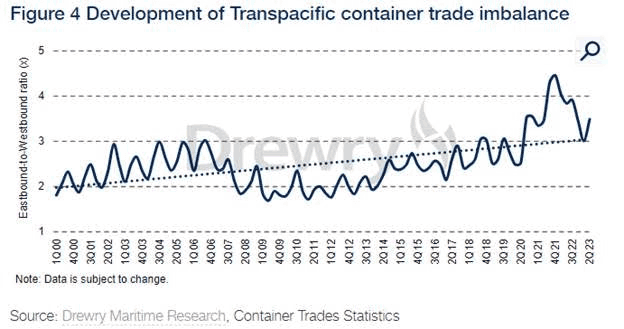One byproduct of the outsourcing of manufacturing and the increasing reliance on China to be the world’s factory starting in the early 2000s, was continuously widening container trade imbalances.
Supply Chain Digest Says... |
 |
|
| Looking at the long-run container imbalance in the Transpacific (Asia to North America) market, Drewry notes that the eastbound-to-westbound ratio has come down from the crazy heights of the pandemic, when it peaked at 4.46 in Q4 of 2021. |
|
 |
|
What do you say? |
|
| Click here to send us your comments |
|
| |
|
| Click here to see reader feedback |
|
|
|
So notes the maritime analysts at Drewry in a recent Container Insights blog posting.
Since 2010, Asia has been the only net exporting region in the world, and its challenge has been to reposition the vast number of empty containers that it needs from everywhere else, Drewry notes.
Drewry says Asia’s requirement for empty containers has grown almost with each passing year in this century. The one exception was in 2009, when the global financial crash depressed container traffic. The pandemic boom year of 2021 pushed the imbalance to new heights, with an estimated four million TEU repositioned from surplus (import) regions to demand (export) areas, as importing nations continued to buy Asian exports. While the imbalance narrowed a bit in 2022, it was still the second highest on record.
North America and Africa import roughly 2.5 times more loaded containers than they export, according to Drewry’s data. That makes steel containers essentially the biggest export trade in those two regions.
“This situation is inefficient, costly and certainly not environmentally friendly,” Drewry notes, adding that “Moving empty shipping containers is currently adding an astronomical “empty miles” cost of at least $16 billion per year,” Drewry estimates.
Drewry also notes that the growing inequality of manufacturing and consumption within regions has increased the risk of container shortages for net exporters (i.e. Asia) and the cost from storage and repositioning of empty containers.
But will companies moving at least some of their sourcing away from China, driven by the need to reduce risk and in some cases being closer to demand change, this static quo?
While China’s share of US container imports from Asia has dropped significantly since the two countries’ trade war (tariffs) erupted in 2018, falling from 69% in 2017 to 59% after five months of 2023, the sheer volume of China to US container trade far outweighs any sourcing diversions for now.
(See More Below)
|
CATEGORY SPONSOR: SOFTEON |
|
|
|
|
|
Add to that the fact that much of the move away from China is simply moving to other low cost Asian countries such as India and Vietnam.
Looking at the long-run container imbalance in the Transpacific (Asia to North America) market, Drewry notes that the eastbound-to-westbound ratio has come down from the crazy heights of the pandemic, when it peaked at 4.46 in Q4 of 2021, as shown in the graphic below. The average ratio in the 1H of 2023 was 3.25, which compares to an average of 3.81 for the full year 2022.

“For the situation to dramatically improve there will need to be a step change in near-sourcing, and generally more levelling up of intercontinental imports and exports across all regions,” Drewry says.
Drewry concludes by noting that a world with a more diverse manufacturing base would contain or even end the costly rise of the long-distance empty repositioning of containers on the big East-West routes, which costs billions of dollars annually.
However, while “The process of spreading the manufacturing load from China is well underway, the country’s export dominance will last for many years, and so too will most of the regional container surpluses and shortages,” Drewry adds.
What are your thoughts on container imbalances? Let us know your thoughts at the Feedback section below.
Your Comments/Feedback
|

